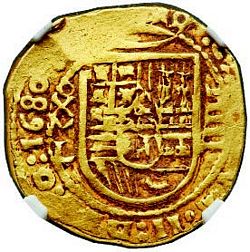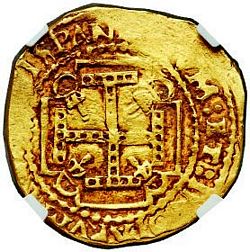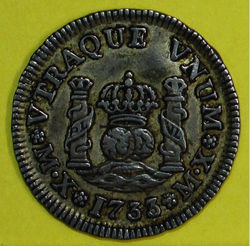The Mxo and Mx Variations in the Mexican Mintmark
by Jorge A. Proctor
On 11 May 1535, a Royal decree was signed in Spain by Queen Isabella of Portugal (as regent of Spain during the absences of her husband King Charles I of Spain, Charles V of the Holy Roman empire) J. A. Proctor, The Assayers of the Mint of Mexico During the 16th Century Pillars Coinage, 1536-1571(?). Numismatics International Inc. NI Bulletin, Volume 50, Nos. 1-2, January-February 2015, p. 2 and endnote 4 on p. 27. Although Joanna did retain her title of Queen until her death in 1555, this remained mostly titular as she had been declared mentally unstable and unable to govern shortly after the death of her husband Philip “the Handsome” of Austria. Since Isabella of Portugal had been recognized as Queen in Spain, the decrees she signed during her periods of Regency were signed with the simple customary phrase of “Yo la Reina” (I the Queen), including the one signed in 1535 for the establishments of the mint of Mexico. authorizing the first mint in America to be established in Mexico, or Tenochtitlán-México, as this city was also referred to by its original Aztec name J. T. Medina, Las Monedas Coloniales Hispano-Americanas (Santiago de Chile, 1919), pp. 54-57; T. Dasí, Estudio de los Reales de a Ocho (Valencia, Spain, 1950), Vol. I, pp. CLXXXII-CLXXXV, No. 207. A complete transcript of the decree from 11 May 1535, can be found in both these sources..
Coin production started in this city of the Viceroyalty of New Spain on 1 April 1536 National Library of France, Mexican Collection No. 298 (Mexicain No. 298), Notes Sur l’or des mines, l’or de tepuztli, etc. This 18th century Mexican report by an anonymous author regarding the tepuzque gold in Mexico, includes the date when the Mint of Mexico first started minting coins, as following: “XX. El Exmo Sr Mendoza traxo consigo estas ordenes saliendo de Espaa, y entró en Mexico en 14 de Noviembre del dicho año 1535 (como se prueba con el cabildo de la ciudad de Mexico celebrado en el Sabado 13 de este mes y año). Uno de los primeros pasos q dio en su acertadísimo gobierno fue el mandar fabricar la Real casa de moneda, la qual se concluyo en postrero de Marzo del siguiente año 1536, y desde luego, es decir desde 1 de Abril, se comenzó a labrar la moneda.”,) and, as it was required by law, and by this decree, it included a mark known as a mintmark, which in this case was a Latin M for Mexico, as an identifier of the mint where they had been minted Medina (op. cit.). Dasí (op. cit), The decree from 11 May 1535 provides the following description for the mintmark given to Mexico, as transcribed in Dasí’s work: “...donde uviere la devisa de las columnas una M. latina que se conozca que se hizo en Mexico.”. In a viceregal order of 28 June 1542, ordering the mintage of “billon” coins in Mexico (as they were called in the order, although they were actually made there with only copper), Viceroy Mendoza directed that a lower-case “o” be added above this M mintmark, as a supplementary mark Dasí (op. cit.), Vol. I, p. CCXXIII, No. 263. A viceregal order from Viceroy Antonio de Mendoza, dated in Mexico on 28 June 1542, ordered the mintage of 12,000 marcos in copper coins (or, as the document states: “bellón sin ley de moneda”), for which, among their design, it includes the use of the Mo mintmark variation for the first time. The design for these copper coins is prescribed in here as follows: “..llevando por armas ‘la de a dos de una parte una columna con el plus ultra e corona, e de la otra parte un castillo e una corona e la señal de Mexico e la de a cuatro de la una parte un castillo y un león con una K en medio con una M devajo con una O encima del nombre de Mexico, e de la otra un castillo e una I y corona y un león e por el letrero de toda la dicha moneda CAROLUS ET JOANA HISPANIARUM ET INDIARUM REX, o lo que cupiere de ello, etcétera’.”. This viceregal order addressed only the new copper coinage and said nothing about the ongoing silver coinage. In the aftermath of the 1542 order uncertainty apparently reigned, with some diesinkers engraving the official mintmark of M alone on the copper and the silver coinage, while others preferred the modified Mo mintmark. This situation persisted until 1571, when the Mo modified mintmark became the standard used in Mexico, which has endured to this day.
But, through its history there appeared two other instances in which the Mexican mintmark was further modified. But the origin of these other modifications has remained a mystery. That is until today.
On 25 February 1675, Queen Mariana of Austria, while serving as the regent of Spain in place of her son, King Charles II, who at the time was a minor, authorized gold coins to be minted in the mint of Mexico for the first time[text needed]. But, unlike in years past, this authorization lacked any Royal decree (ordenanza) vetted by the Council of the Indies, providing the guidelines to follow for such production or even any dies, punches or other customary items that were normally sent to assist with the initial production of a new type of coin. This caused much confusion, for which, from Mexico, a formal request was sent to Spain, to provide the much-needed guidelines Archivo General de la Nación (AGN), Instituciones Coloniales, Real Hacienda, Casa de Moneda 021, Volumen 333, Expediente 1. Title: Autos tocantes a la Labor de monedas de oro, que en virtud de Real cedulas manda Su Magestad Corran en este Reyno, y se labren en la Real Cassa de la moneda desta Ciudad..
By 1679 this request had been answered, and the coining of gold could finally begin. But, among the information received from Spain there seemed to be a problem. According to the responses, when it came to the mintmark to be used on the newly minted gold coins, Mexico was told that: “And by the first ordinance it is ordered that below the royal arms be placed the first letter of the city where the coins were minted, and in its conformity, on the decree of eleven May 1535, in the Second paragraph, it is ordered by his Majesty, that in the coins minted in the mint of this city, a Latin M be placed, and it will be convenient to add an X, as it is executed on the silver coins, so as to differentiate the gold coins from the ones minted in the Village of Madrid…” AGN (ibid.). From the original: “Y por la ordenanza prímera está mandado q debajo de las armas reales se ponga la primera letra de la Ciudad donde se labraren las monedas, y en su conformídad en la cedula de onze de Mayo de 1535. En el parrapho Segundo, tiene mandado su Magestad que en las monedas, q se labraren en la cassa desta Ciudad se ponga vna M. Latína, y convendrá q se añada una X. como se executa en las monedas de Plata, para q se differencíen las monedas de oro de las que se labraren en la Villa de Madrid…”
It is clear that the Spanish authorities were in error. In fact, Mexico had never had an X as part of its mintmark, but an “o”, as previously stated. But the mention of adding an X with the M mintmark (an MX) to the gold coinage would now create a new hurdle that needed to be overcome, and there were few options to do so:
- Mexico could request further clarification from Spain, which would unquestionably ensure an even longer delay in the mintage of the gold coins, which were already behind schedule.
- They could decide to ignore the recommendation of Spain and risk disapproval.
- They could just put the MX and ignore the fact that the modified mintmark used on the silver was an Mo.
- They could just add the MX recommended by Spain, while still including an “o” above it, thus maintaining the grammatical rules of the period for abbreviations, which called for the arrangement of letters to be used, when placed in a vertical fashion, to include the first letter of the name in the lower position, and the last letter of that name, in the highest position (or above it).
This last option appears to have been the most favored, as it allowed for them to maintain a sense of agreement with Spain’s suggestion, while at the same time keeping a resemblance between the mintmark, as seen in the silver coinage, and that which would now be used on the gold coinage, even if both did not have all the same supplementary marks.
As documented on 17 October 1679, the Treasurer of the mint proceeded to asking the diesinker to make a sample, which was then included with the report sent to Don Martín de Solís Miranda, Fiscal of the Audiencia of Mexico The Fiscal of the Audiencia was the Crown’s prosecuting attorney assigned to that high tribunal and a legal representative of the Viceroy . After being seen by the Fiscal, a response followed, which stated: “And the Fiscal does not find difficulty, that the stamp and imprint (“estampa y sello”) by which it is fashioned in Castile be made, with the quality that in it be stamped a Latin M, and X and an O , so that it is recognized that the coins have been minted in this mint of Mexico” AGN (op. cit. n. 6). From the original: “La Segunda Causa, que representa el Thesorero es no haver tenído orden del sello con que se habían de acuñar dichas monedas, y que en conformídad de la respuesta fiscal en que pediá se hiciesse, y estampasse por el de las monedas de Castilla, hizo que el Tallador hiciesse vna muestra, que es la que Se presenta con el informe, Y no halla dificultad el fiscal, que haga la estampa y sello por el que se estila en Castilla, con la calidad de que en el se estampe vna M. Latina, vna X. y vna O, para que se reconossca haverse labrado las monedas en esta cassa de Mexico, como se dispuso para la labor de la moneda de Plata en la real cedula de once de mayo de 1535. en el parrapho Segundo de ella…”.)


Mexico 4 escudos dated 1680 and showing the MXo mintmark variation above a letter L, as used to identify assayer Manuel de León.
(Heritage Auctions, 2018 April 20 - 23 CCE World Coins Signature Auction - Chicago #3064, Lot #31316)
Mexico City finally was able to start its gold coin production on 23 December 1679, and from that date until the end of 1713, all gold coins minted there displayed this new modified mintmark of MXo. But then, as the coins demonstrate, a change would be instituted in Mexico for the 1714 coinage, ending the use of the MXo modified mintmark, which was then replaced with the more familiar Mo used on the silver coins.
With the 1714 standardization of the Mexican mintmark through its entire monetary system, this should have been the end of this story. But this is not the case. Spain was never made aware of their mistake in suggesting the use of an X with the M mintmark (an MX) for the gold coinage; a suggestion arising from their belief that this was the way the mintmark was being presented on the silver coinage. This would cause this issue to be resurrected again some 50 years after its first mention.
On 9 June 1728, as part of the eighteenth century “Bourbon Reforms” of King Philip V, a Royal decree was signed to reform the Spanish-American mints, being then followed by a separate decree on 16 July 1730 that spelled out in greater detail the new mint regulations. These reforms called for the fineness on the silver coins to be lowered, the design of the gold and silver coins to be changed, and for the new gold and silver coins to be minted under modern minting techniques through mechanization, thus creating perfectly round coins, which would now also have an edge design to prevent shaving or clipping (milled coins).
As part of this new monetary reform, Mexico was selected as the site where it would be first implemented, and, as it was customary, new dies, or better said, partial dies The practice of the period was to engrave the dies in their entirety, only lacking the year or its last digit, and the assayer mark, as with the customary delays of the period, these were marks that were better known at destination, being engraved shortly before coin production was to commence.,) were engraved in Madrid and provided to the newly selected mint director for the Mexican mint, Nicolás Peinado Valenzuela, so that he could arrange for their shipment to Mexico Archivo General de Indias (AGI): México, 749..
Nicolás Peinado traveled to Mexico in the Spanish warship San Juan Bautista, the Almiranta of the Mercury squadron of 1730 under the command of Squadron Commander Don Rodrigo de Torres, being accompanied by his assistant, Don Alonso García Cortés, and Francisco Monllor, the new Mexico Mint diesinker AGI: Contratación, 1326..)
At Mexico, when completing the preparations for the commencement of the mintage of the new coinage in 1732, Director Nicólas Peinado became aware that the dies received by him in Madrid had incorrectly been engraved with an MX mintmark, at which time, the diesinker, Monllor, had even started engraving the final 2 to the date, to reflect the year of 1732. This became a subject of contention between the mint director and the diesinker, with Monllor strongly supporting the use of these dies with the MX, as he believed that, since they had been engraved with it in Spain, this made them legal to use and Peinado determined to have new dies made with the correct Mo, and not to use the dies with the MX, pending the determination by Spain, as to what to do with them. AGI ((op. cit. n. 11). From the original 1732 letter by Mint Director Nicolás Peinado: “También en los Truqeles que se me entregaron en Madrid para distintivo de esta Cassa se puso Vna M y X. y aca esta en practica Mo esta zifra la que le a parecido al siguiente prosiga, lo que tanbien es necesario se resuelva.”.

Translation from the original 1732 letter by Mint Director Nicolás Peinado: “Also in the dies that were handed to me in Madrid, as distinguisher for this mint, it was placed an M and X, and here it is in practice Mo, this figure which the following thought should continue, which is also necessary to be resolved.”
Image courtesy of fellow numismatic researcher Glenn Murray, who is credited with the discovery of
this document in the General Archives of the Indies (AGI: Mexico, 749)
But the Spanish response must have been that since the expenditure had already been incurred on the MX dies, to proceed with the use of these dies, until they were consumed, which is what was done in 1733. At this time, even the few dies that had been previously completed with the 1732, were reengraved with a 3 over the 2, thus reflecting the year in which they would be used, 1733. The MX mintmark variation is known in all denominations in silver for 1733 (with 1733/2 known). No gold coins are known with this mintmark variation. One of the 8 reales dies that had been dated 1732, and not corrected for use in the 1733 production, is held to this date in the Mexico Mint collection.

An unused 8 reales reverse die, as engraved in Madrid with the MX mintmark variation, but showing the completed date of 1732, as engraved by diesinker Francisco Monllor in Mexico. (this is the only known 8 reales MX die and I would like to thank the Casa de Moneda de Mexico for providing images and for all their support).
Source: “Colección Casa de Moneda de México/ Museo Numismático Nacional”.


half real coin, minted with the MX mintmark variation and the date of 1733
(image provided by the Casa de Moneda de México).
Source: “Colección Casa de Moneda de México/Museo Numismático Nacional”, folio 94.
